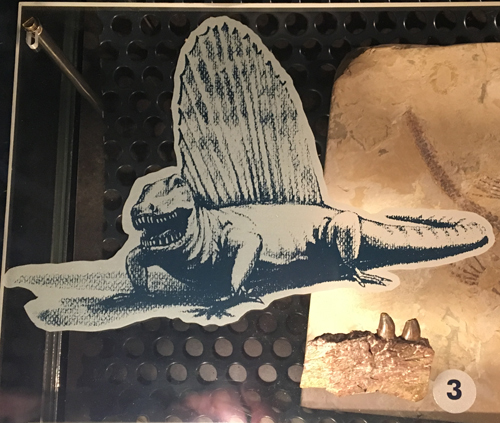Why is Dimetrodon regarded as a Dinosaur? A Helpful Explanation
Why is Dimetrodon regarded as a Dinosaur?
When browsing through any young person’s dinosaur collection I often remark on how many times a model of a Dimetrodon appears. Dimetrodon seems to have entered our collective consciousness as a dinosaur, it certainly looks like it should belong to Dinosauria (the collective name for dinosaurs), but Dimetrodon and its kind were long gone before the dinosaurs evolved.
Dimetrodon
Dimetrodon was a fierce carnivore of the Permian period (about 286 mya to 248 mya) and it is famous for having a large “sail”. It certainly was a top predator but it was no dinosaur. In fact Dimetrodon belonged to a group of reptiles called pelycosaurs, which were in fact more closely related to mammals than they are to dinosaurs.

The Dimetrodon jaw fragment exhibit at the National Museum (Cardiff). Picture credit: Everything Dinosaur.
Picture credit: Everything Dinosaur
It belonged to a group of vertebrates that had a single opening (fenestra) just behind the eye socket in the skull. Dinosaurs, lizards, crocodiles, birds and marine reptiles were diapsids (two holes on each side of the skull). The purpose of these holes is unknown but it is thought that they originally evolved to allow the passage of jaw muscles to aid biting and chewing as animals began to exploit different food sources as they established themselves on land. Mammals are also synapsids, they have a modified synapsid opening in the skull – so Dimetrodon was a relative.
As far as we know (this is what the fossil record tells us), the pelycosaurs thrived during the Permian period, but they do seem to have been restricted to what was North America and Europe. They were certainly very successful, some scientists have estimated that at the height of their success 70% of all land vertebrates on Earth were pelycosaurs of one sort or another.
This does not explain how Dimetrodon came to feature in lots and lots of dinosaur model sets. This is not a modern phenomenon, Dimetrodon seems to have featured from the very beginning, when plastic models first started to be produced.
To view the range of prehistoric animal figures available from Everything Dinosaur including replicas of pelycosaurs like Dimetrodon: Dinosaur and Prehistoric Animal Replicas.
Plastic Models
The first plastic dinosaur model sets were manufactured in the mid 1950s and they were often provided as free gifts with cereals and other foodstuffs (called premiums I think!). Linde the Austrian confectionery manufacturer and coffee maker offered customers the chance to collect a set of nine olive green plastic prehistoric animals with their coffee purchases – and Dimetrodon was included. Other companies began to offer plastic models with their food products, for example, the U.S. firm Nabisco offered a set of different coloured plastic prehistoric animal models and in the series was one called “Fin-back Dinosaur” clearly a model of a pelycosaur but already the identity of Dimetrodon and its kin was becoming blurred.
Free Gifts with Breakfast Cereals
In the UK, we cannot say we did not do our bit to confuse everyone over the exact identity of Dimetrodon. One of the first plastic model premiums offered by Shreddies in England was for a 20-piece prehistoric animal collection and there amongst the dinos was Dimetrodon.
Perhaps the sail-back is Dimetrodon’s undoing. If an artist is looking to sculpt a set of plastic models, Dimetrodon would certainly stand out and I suspect the body shape would be relatively easy to work with. Dimetrodon certainly features in lots of different model series from many manufacturers.
Sticking a plastic sail onto the back of an iguana or monitor lizard as a “special effect” would give the animal a prehistoric appearance. Perhaps this is why in films such as the “Lost World” and “Journey to the Centre of the Earth” we see lizards dressed up with fins and sails representing Dimetrodon on the big screen as it were. This could perpetuate our misconception about Dimetrodon being a dinosaur.
No matter how Dimetrodon came to be viewed as being a Dinosaur, it seems likely to remain linked in the minds of the public for a very long-time to come. Despite the best efforts of palaeontologists to explain that the last of the pelycosaurs died out millions of years before the Dinosaurs got established, it seems that it is now accepted by many that Dimetrodon was a dinosaur.
I suppose it is easier for people to accept that a 3.5-metre-long monster with sharp teeth weighing as much as 200 kilograms is more closely related to a T. rex than it is to us.

